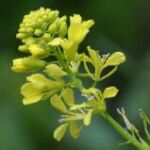| Common Name: |
Black Mustard |
| Other Names: |
Brown Mustard, Mustard Seed, Red Mustard |
| Botanical Name: |
Brassica nigra syn. Sinapsis nigra |
| Genus: |
Brassica |
| Family: |
Brassicacea |
| Native Location: |
Eurasia |
| Cultivation: |
Rich, well-drained, neutral to alkaline soil in full sun. |
| Propagation: |
By seed sown in early spring. |
| Harvest: |
Leaves and flowers are picked when young and used fresh. Pods are harvested as they begin to change color, and dried to complete the ripening process; this prevents the seeds frmo being shed in the field. Seeds store indefinately if kept dry. Volatile oil is distilled from seeds. |
| Height: |
90cm-3m (3-10ft) or more |
| Width: |
90cm-1.2m (3-4ft) |
| Hardiness: |
Hardy |
| History: |
By all accounts, the ancient Romans were simply mad about mustard. They ate it with anything and everything, mixed it with wines, and used it in over 40 medicinal remedies. No doubt, the Romans were among the first to discover that mustard, as the British herbalist John Gerard noted in the sixteenth century, "is an excellent sauce, good to be eaten with any grosse meates, either fish or flesh, because it doth help digestion, warmeth the stomache and provoketh appetite." The Romans also gave mustard its distinctive name, a combination of the Latin mustum (the Roman name for newly fermented wine) and ardens (for "burning"). When the conquering Romans brought mustard to the British Isles, the English fell in love with it as well—for its taste and therapeutic value—and mustard cultivation and manufacturing soon spread throughout the Continent and became a thriving industry. |
| Parts Used: |
Leaves and flowers, seeds, oil
Young leaves may be added to salads and soups. The leaves of black mustard are stronger than those of white mustard (B. hirta) and brown (B. juncea) mustards. Whole seeds are used as a spice. Crushed seeds and powdered mustard are used medicinally. Black mustard is not as widely available as the milder brown mustard, the the latter is a good substitute. |
| Properties: |
A pungent, warming herb that stimulates the circulatory and digestive systems, and irritates the skin and mucous membranes. It is a potent emetic in large doses. |
| Medicinal Uses: |
Externally, in poultices, mustard bandages, and baths for rheumatism, muscular pain, chilblains, and respiratory tract infections. A mustard footbath is a traditional remedy for colds and headaches. Skin contact with mustard causes reddening, thus increasing blood flower and removal of toxins. Prolonged contact may result in blistering, especially in those with sensitive skin.
To treat sciatica, bronchial pneumonia, sinusitis, the common cold, rheumatism, and arthritis; in footbaths to treat aching feet.
Mustard has appetite-stimulating, digestive, diuretic, emetic, irritant, and blood-stimulating properties. In old herbals, mustard is sometimes prescribed for internal use in small doses. A teaspoon to a tablespoon of mustard powder (pulverized seeds) in a glass of warm water was recommended both to cure hiccups and to induce vomiting. Some present-day herbalists still recommend ingesting small amounts of mustard to increase the appetite, but most practitioners prescribe mustard for external use only—in footbaths, plasters, and compresses—to stimulate blood circulation, relieve chest congestion, and ease rheumatic pain. |
| Preparation: |
Mustard powder is available in most supermarkets. Commercial mustard plasters are available in some health stores and pharmacies. To make a simple mustard footbath—which will stimulate blood circulation and relieve aching feet—add 2 tablespoons of mustard powder or 1 tablespoon of crushed seeds to 1 quart of warm water and stir well. Soak feet for 10 to 15 minutes. |
| Caution: |
Mustard can be very irritating to the skin and mucous membranes; it should always be used in diluted form. If you have especially sensitive skin, avoid using it entirely. |
| Possible Side Effects: |
Black mustard can cause diarrhea, vomiting, stomach pain, difficulty breathing, and coma. Applied topically, black mustard's side effects include blistering of the skin and skin allergies. |
| Drug Interactions: |
| Taking black mustard with these drugs may interfere with the actions of the drug: |
| Aluminum Hydroxide (AlternaGel, Alu-Cap) |
Aluminum Hydroxide and Magnesium Carbonate (Gaviscon Extra Strength, Gaviscon Liquid) |
Aluminum Hydroxide and Magnesium Hydroxide (Maalox, Rulox) |
Aluminum Hydroxide and Magnesium Trisilicate (Gaviscon Tablet) |
| Aluminum Hydroxide, Magnesium Hydroxide, and Simethicone (Maalox, Mylanta Liquid) |
Calcium Carbonate (Rolaids Extra Strength, Tums) |
Calcium Carbonate and Magnesium Hydroxide (Mylanta Gelcaps, Rolaids Extra Strength) |
Cimetidine (Nu-Cimet, Tagamet) |
| Esomeprazole (Nexium) |
Famotidine (Apo-Famotidine, Pepcid) |
Famotidine, Calcium Carbonate, and Magnesium Hydroxide (Pepcid Complete) |
Lansoprazole (Prevacid) |
| Magaldrate and Simethicone (Riopan Plus, Riopan Plus Double Strength) |
Magnesium Hydroxide (Dulcolax Milk of Magnesia, Phillips' Milk of Magnesia) |
Magnesium Sulfate (Epsom Salts) |
Nizatidine (Axid, PMS-Nizatidine) |
| Omeprazole (Losec, Prilosec) |
Pantoprazole (Pantoloc, Protonix) |
Rabeprazole (Aciphex, Pariet) |
Ranitidine (Alti-Ranitidine, Zantac) |
| Sodium Bicarbonate (Brioschi, Neut) |
Sucralfate (Carafate, Sulcrate) |
|
| Disease Affects: |
May worsen ulcers in the stomach or small intestines by irritating the lining of the stomach or small intestine. |
| Culinary Uses: |
Young leaves and flowers add pungency to salads. Seeds are ground to make mustard powder or dry mustard, mixed with vinegar as a relish, and used whole in curries, pickles and sausages. |
| Bibliography: |
Encyclopedia of Herbs by Deni Brown Copyright © 1995, 2001 Dorling Kindersley Limited Pp 146-147
The Essential Herb-Drug-Vitamin Interaction Guide by Geo. T. Grossberg, MD and Barry Fox, PhD Copyright © 2007 by Barry Fox, PhD Pp.79-80
The Modern Herbal Primer by Nancy Burke Copyright©2000 Yankee Publishing, Inc. pp. 33-34 |

